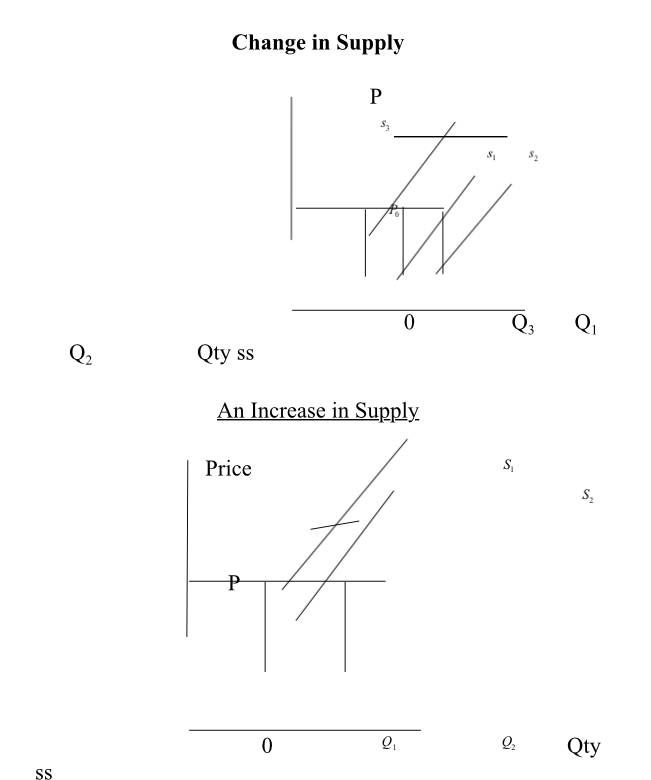Change in Quantity Supplied and Change in Supply
Change in Quantity Supplied
A change in quantity supplied refers to a movement along the same supply curve. This movement is practically the result of changes in the price of a commodity. As the price of a commodity changes we are at different points on the supply curve. As illustrated in the diagram below, at price we are at point A with quantity
supplied. A change in price to
puts us at point B with a different quantity
Price is associated with point C and quantity
. It is clear from the above that with changes in the price of a commodity, quantity supplied of that commodity also changes. This is under the assumption that all determinants of supply remaining constant except price.
Change in Supply
A change in supply refers to a boldly shift in the supply curve either to the right or to the left. A shift to the right is known as an increase in supply. It means that at the old price a greater quantity is supplied of the commodity. A shift to the left is known as a decrease in supply. It means that at the old price a smaller quantity is supplied of the commodity. This is illustrated in the following figure.
With reference to the figure above, at price P, using the original supply curve SS, quantity supplied is. Because of the shift in the supply curve to the right, at the old price P a greater quantity
is supplied.
A shift to the left in the supply curve is known as a decrease in supply. The meaning is that at the same old price,, a smaller quantity,
, is supplied of the commodity. As illustrated in the figure below, given the price
quantity supplied stands at
, using the original supply curve
. With the shift in the supply curve to the left
, a smaller quantity
is supplied at the same price.
It is clear from the analysis above that the price of the commodity remains constant but quantity supplied changes. The cause of these changes is that we have changes in any of the factors that determine the supply of a commodity price being constant. These changes include changes in technology changes in the prices of other commodities, changes in weather, changes in acts of nature, etc.
Factors Responsible for an Increase in Supply
According to our analysis, an increase in supply is a shift in the supply curve to the right, i.e. at the same price more quantity of the commodity is supplied. The following are the causes of such an increase in supply.
All the above factors discussed will lead to a shift in the supply curve to the right. This has already been discussed above.
Factors Responsible for a Decrease in Supply
With reference to what has already been discussed, a decrease in supply will be a shift in the supply curve to the left. This means that at the prevailing price less is supplied of a commodity. Factors responsible for a decrease in supply are discussed below:
Types of Supply
Supply is said to be joint when two or more commodities are produced together during production process or activity. If a single production process leads to the production of two or more product, the commodities are said to be jointly supplied or complementary. For example, Production of Palm oil leads to the production of palm kernel. Therefore, palm oil and palm kernel are considered to be jointly supplied. When there is a change in demand for one, it will affect the quantity supply of the other. For example, if there is an increase in demand for palm oil and therefore the price of palm oil increases, this will result in an increased in the supply of palm oil, which will also lead to an increase in the supply of palm kernel.
From the diagram, palm oil and palm kernel are jointly supplied. The demand for palm oil increases and as a result, the price of palm oil increases from P1 to P2. This in turn brings about an increase in the quantity supplied of palm oil from Q1 to Q2, given the demand for palm kernel, surplus is created, and hence the price of palm kernel falls from P2 to P1.
Commodities are competitively supplied if they are produced from the same input such that an increase in the supply of one leads to a decrease in the supply of the other. That is goods which can be produced using the same factors of production are said to have a competitive supply because, the production of one commodity will generally require a reduction in the output of the other. For example, with a given amount of land, a farmer can produce either maize or millet. Maize and millet thus have competitive supply. The two commodities therefore compete for the same inputs. Assuming an increase in the price of millet, producers will devote more land to produce more millet than that of maize.
From the diagram, millet and maize are competitive supply. An increase in the demand for millet, leads to an increase in price, the effect is that it brought about a decrease in the supply of maize.
A commodity has a composite supply if its total supply can come from different sources. For example, meat can be supplied from cattle, sheep, or goats, etc. Akpeteshie can be supplied from palm-wine, sugar molasses or mangoes. This implies that, an increase in the supply of one of the sources will increase the total supply of the commodity in general but a reduction in the supply from one of the sources will lead to a general reduction in the supply of the commodity and raises the price of the commodity.


